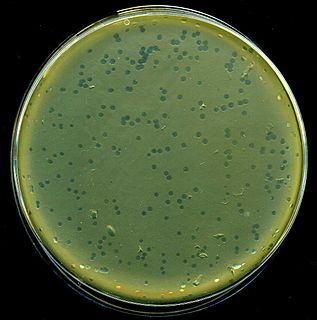
Enterobacteria phage λ is a bacterial virus, or bacteriophage, that infects the bacterial species Escherichia coli. It was discovered by Esther Lederberg in 1950. The wild type of this virus has a temperate lifecycle that allows it to either reside within the genome of its host through lysogeny or enter into a lytic phase ; mutant strains are unable to lysogenize cells – instead, they grow and enter the lytic cycle after superinfecting an already lysogenized cell.

The Myoviridae is a family of bacteriophages in the order Caudovirales. Bacteria and archaea serve as natural hosts. There are currently 93 species in this family, divided among four subfamilies and 30 genera.

Podoviridae is a family of viruses in the order Caudovirales. Bacteria serve as natural hosts. There are currently 50 species in this family, divided among 20 genera. This family is characterized by having very short, noncontractile tails.
Autographivirinae is a subfamily of viruses in the order Caudovirales, in the family Podoviridae. Bacteria serve as natural hosts. There are currently 15 species in this subfamily, divided among 3 genera.
Phikmvlikevirus is a genus of viruses that infect bacteria. There are currently four species in this genus including the type species Pseudomonas phage phiKMV. Bacteriophage phiKMV and its relatives are known to be highly virulent phages, producing large clear plaques on a susceptible host. The only reported exception is phage LKA1, which yields small plaques surrounded by a halo. While all other P. aeruginosa-specific phikmvlikeviruses use the Type IV pili as primary receptor, LKA1 particles attach to the bacterial lipopolysaccharide layer.
Pseudomonas phage phiCTX is a virus of the family Myoviridae, genus P2like virus.
The Phi11 Holin Family constitutes the Holin Superfamily I.
The Phage 21 S Family is a member of the Holin Superfamily II.
The T7 Holin family is a member of the Holin Superfamily II. Members of this family are predominantly found in Caudovirales and Proteobacteria. They typically have only 1 transmembrane segment (TMS) and vary from 60 to 130 amino acyl residues in length. A representative list of proteins belonging to this family can be found in the Transporter Classification Database.
The HP1 Holin Family is a member of the Holin Superfamily II. Proteins in this family are typically found to contain two transmembrane segments (TMSs) and range between 70 to 80 amino acyl residues (aas) in length. A representative list of proteins belonging to the HP1 holin family can be found in the Transporter Classification Database.
The PRD1 Phage P35 Holin Family is a member of Holin Superfamily III. The prototype for this family is the lipid-containing PRD1 enterobacterial phage holin protein P35 encoded by gene XXXV (orfT). It is a component of a typical holin-endolysin system which functions to lyse the host bacterial cell.
The Pseudomonas aeruginosa Hol Holin Family is a group of transporters belonging to the Holin Superfamily III.
The Bacillus subtilis φ29 Holin Family is a group of transporters belonging to the Holin Superfamily IV. A representative list of members belonging to the φ29 holin family can be found in the Transporter Classification Database.
The Holin Hol44 (Hol44) Family is a group of transporters belonging to the Holin Superfamily V. A representative list of proteins belonging to the Hol44 family from caudovirales and firmicutes can be found in the Transporter Classification Database.
The holin LLH family is a group of transporters belonging to the Holin superfamily VI. The Holin LLH family is found in Firmicutes and phage of Firmicutes as well as other bacteria. Members are fairly large, between 100 and 160 amino acyl residues in length, and have an N-terminal transmembrane segment (TMS). Some proteins, such as putative holin of Fusobacterium varium, may exhibit 2 TMSs. A representative list of proteins belonging to the Holin LLH family can be found in the Transporter Classification Database.
The Lactococcus lactis Phage r1t Holin Family is a family of putative pore-forming proteins that typically range in size between about 65 and 95 amino acyl residues (aas) in length, although a few r1t holins have been found to be significantly larger. Phage r1t holins exhibit between 2 and 4 transmembrane segments (TMSs), with the 4 TMS proteins resulting from an intragenic duplication of a 2 TMS region. A representative list of the proteins belonging to the r1t holin family can be found in the Transporter Classification Database.
The Neisserial Phage-associated Holin (NP-Holin) Family is a family of small proteins, between 47 - 53 amino acyl residues in length, that exhibit a single N-terminal transmembrane segment (TMS). Although annotated as phage proteins or holins, NP-Holin proteins are not yet functionally characterized, thus more research is needed to confirm holin activity. A representative list of proteins belonging to the NP-Holin family can be found in the Transporter Classification Database.
The SPP1 Holin Family consists of proteins of between 90 and 160 amino acyl residues (aas) in length that exhibit two transmembrane segments (TMSs). SPP1 is a double-stranded DNA phage that infects the Gram-positive bacteria. Although annotated as holins, members of the SPP1 family are not yet functionally characterized. A representative list of proteins belonging to the SPP1 Holin family can be found in Transporter Classification Database.
The Actinobacterial Phage Holin (APH) Family is a fairly large family of proteins between 105 and 180 amino acyl residues in length, typically exhibiting a single transmembrane segment (TMS) near the N-terminus. A representative list of proteins belonging to the APH family can be found in the Transporter Classification Database.




